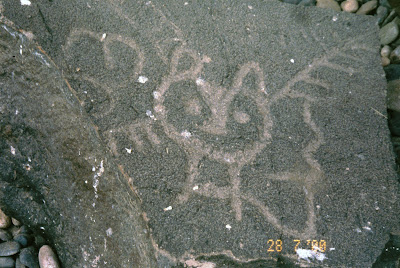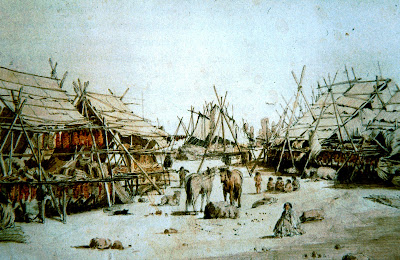During the summer of this year (2022) I was contacted by the editor of a niche publication named the National Button Bulletin concerning a photograph from a previous column in RockArtBlog. On 2 August 2010, I had posted a column titled “Birds in Rock Art – The Spedis Owl.” This refers to a number of distinctive owl petroglyphs found in the Columbia River gorge in an area centered around the Dalles Dam. I was told that a writer named Anne Morgan was working on an article on buttons with owl motifs and that she was including a button with the Spedis owl portrayed on it. I provided the above photograph of one Spedis owl petroglyph and subsequently received a pre-publication copy of the article.
“The Spedis Owl is a petroglyph that originally stood above Celilo Falls on the Columbia River in Oregon. The falls were destroyed by the Dalles Dam project in the 1950s. Prior to its flooding, Celilo Falls stood for over 10,000 years as an iconic salmon harvest and multi0tribal gathering site for Pacific Northwest Native Americans. It is not known which tribe drew the image on the rock or what the owl figure represented. One (among many) Northwest stories describes the Spedis Owl as a River Guardian, a protector of fishers and travelers from the water devil who lived within the dangerous and rolling Celilo Falls (Melin and Dolezal, n.d.). Prior to the Dalles Dam flooding, the Army Corp of Engineers salvaged the Spedis Owl and other related petroglyphs. They are now located in Columbia Hills State Park along the Washington side of the Columbia River. (Faris 2020)”
The information provided to Morgan by Melin and Dolezal is not strictly correct. The distinctive Spedis Owl petroglyphs are in the vicinity of the site of a previous village of the Wishram people named Nixluidix, which is now beneath the reservoir created by The Dalles Dam. Melin and Dolezal also discuss the Spedis Owl as “a River Guardian, a protector of fishers and travelers from the water devil who lived within the dangerous and rolling Celilo Falls.” (Melin and Dolezal n.d.) Celilo Falls, where The Dalles Dam is now located, was a prime fishing location for harvesting salmon. The Wishram people of Nixluidix were prosperous traders of dried salmon harvested from the Columbia River.
“Located near Five Mile Rapids, the
village was located at the far eastern reach of Chinookan lands. Archaeologists
believe the site was occupied for about 10,000 years. The village was a common
trading site for Indians in the surrounding areas, acting as a link between
tribes from the Pacific Coast, and the interior Northwest. The site was visited
by nearby Yakamas, as well as those from as far away as the Nez Perce, who
would come to trade fish, berries, skins, buffalo, amongst many other items.
The village was visited during the westward journey by Lewis and Clark, and again on their eastward return journey, though by the time of the second visit, the village was at a site about 300 yards (270 m) downstream from the site visited the previous fall, Lewis and Clark estimated that there were about 600 people living at the site during the first visit (October 1805), and around 1,000 during the second visit (April 1806). Clark noted in his journals that there were about 20 wooden houses at the site, near a man-made earthen mound called Wakemup (or Wakamup) Mound.” (Wikipedia)
Although Clark had mentioned and sketched rock art in a few instances in the journal that he kept on their trip, he did not mention any rock art at Nixluidix from both their visits there, so Lewis and Clark apparently missed out on the Spedis Owl. The name Spedis is believed to have been taken from an early farmer, a Mr. Spedis, who homesteaded there (James Keyser 2000: pers. comm.) Indeed, the 1930 US Federal census listed fifteen members of the Spedis family still residing in Klickitat County, Washington.
I am quite tickled to have been a small part of this commemoration of a charming rock art theme.
NOTE: Some images in this posting were retrieved from the internet with a search for public domain photographs. If any of these images are not intended to be public domain, I apologize, and will happily provide the picture credits if the owner will contact me with them. For further information on these reports you should read the original reports at the sites listed below.
PRIMARY REFERENCES:
Faris, Peter, 1970, Birds in Rock Art – The Spedis Owl, https://rockartblog.blogspot.com/2010/08/birds-in-rock-art-spedis-owl.html
Morgan, Anne, 2022, Much More Than the Wise Old Owl: Myths, Art and Culture, October 2022, The National Button Bulletin, pp. 161-167
Wikipedia, Wishram Village, https://en.wikipedia.org/wiki/Wishram_village.












No comments:
Post a Comment